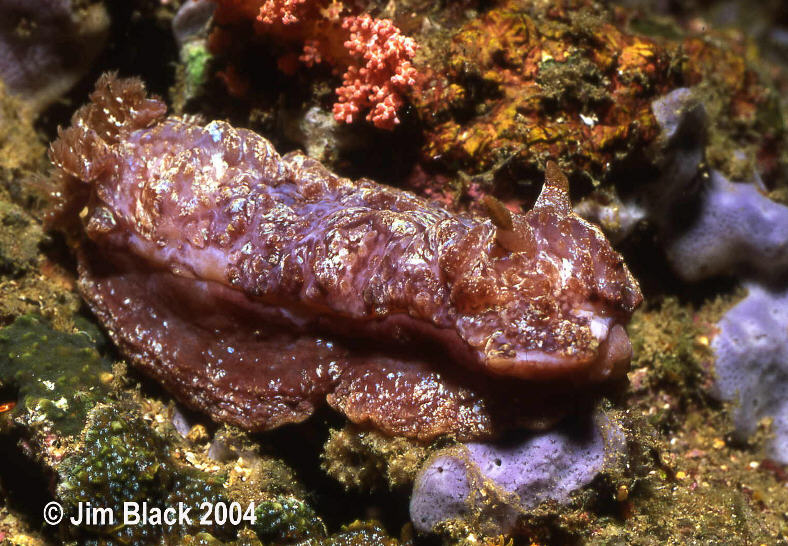 |
Atagema spongiosa
Batangas, Philippines
Photo courtesy of Jim Black
Atagema spongiosa, (Kelaart, 1858)
Well leave it to good ole buddy Jim Black , prominent member of the Ugly Americans dive club, to send us something we haven’t seen after a dozen years and 100’s of dives looking for new species of opisthobranch in the Anilao area of Batangas, Philippines. I tell ya – it takes guts to find something the “Branch-magnet” Terry Gosliner hasn’t seen there.
So what the heck is this gorgeous beauty? It looks more like a cryptobranch than a phanerobranch in shape. There are no extra-branchial processes, and no caryophyllidia. The body has no ridges or other physical give-away features, but the foot is separated by a deep hyponotal indentation. The foot appears to be much wider than the body. The notal surface is a beautiful color but it sort of has the appearance to a fifth degree burn victim. There is really no pattern to the mounds and convolutions of this surface. The body is divided anteriorly giving the appearance of a head region similar to a Ceratosoma . It does seem to have raised rhinophore pockets.
My best guess is it might belong to the genus Aphelodoris , but believe me that's only a guess. In a way it could be a wild variation of Aphelodoris greeni , but even that's a stretch. Aphelodoris berghi has strange notal mottling so that's a possibility also. The problem is both of these species occur in southern Tasmania, slightly colder than the Batangas region of the Philippines.
Jim found it found under a large dead piece of plate coral at about 50 ft. deep. Maybe that's why we haven't seen this one. Its been hiding all the time.
We this one has got me stumped. If anyone has any ideas, please let Webmaster Mike, Jim and I know.
Danville, Calif
Jun, 2004
Well folks, the responses are already coming in!
Note from Angel Valdes, June 1, 2004.
"...In looking at this specimen, a Discodoris comes to my mind, because some
species of
Discodoridae can detach their mantle completely when they are under stress.
In Jim's
case the mantle seems to be in the process of regenerating. If you look
closely the foot looks
proportionally too wide compared to the dorsum, and the rhinophoral sheaths
are also too high, so
it seems like the mantle is missing from the animal. I have seen some
Discodoridae getting rid
of big chunks of their mantle margin in seconds, and I think the genus
Fracassa was described
based on a Discodoris that was missing the mantle, just like your specimen..".
WEBMASTER'S NOTES, June 18th, 2004
Well, as it turns out Folks, Angel Valdes of the Los Angeles County Museum hit the nail right on the head! While in the process of digitizing all my slides from the Philippines, I came
across an
image of our "mystery branch" with its mantel intact. Angel suspects our unknown is Atagema spongiosa , so thats where we are going to hang our identity hat for the time being. Thanks a bunch Angel!!
Jim Black in cockpit
 |
Captain 27 years with US Airways...currently flying Airbus 330 Internationally. Diving since 1970...with over 5200 dives logged. Shoots Nikon F4s in housing and Nikonos RS. Jim's photography has been featured in a number of books and publications including Helmut Debelius' Nudibranchs and Sea Snails of Gosliner, Behrens and Williams Coral Reef Animals of the Indo-Pacific. A photo of Jim petting a shark in "Sleeping Shark Caves" off Isla Mujeres Island, Mexico, taken by Amy Foster his significant other, recently appeared in Dave Behrens' Diving Guide to Cozumel, Cancun & The Riviera Maja. Send Jim email at jim.black1@comcast.net |
Taxonomic information courtesy of:

David W. Behrens
Author:
Pacific Coast Nudibranchs
Send Dave mail at dave@seachallengers.com
|
